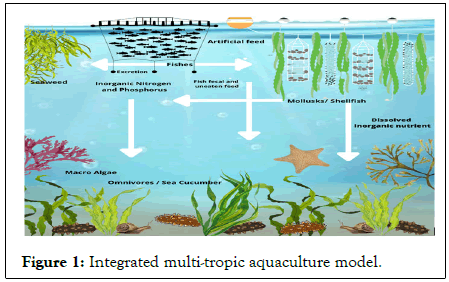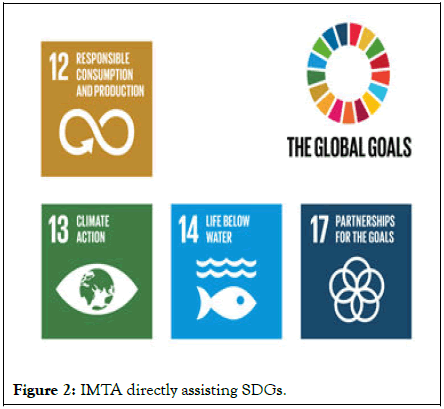Fisheries and Aquaculture Journal
Open Access
ISSN: 2150-3508
ISSN: 2150-3508
Review Article - (2023)Volume 14, Issue 3
For hundreds of people worldwide, fishing and aquaculture continue to be vital sources of food, nutrition, revenue, and livelihoods. The development of innovative culture techniques and the enhancement of culture systems for the blue revolution are products of the expansion of the fisheries and aquaculture industries. Integrated Multi-Trophic Aquaculture is one such system (IMTA). Using water-borne nutrients and energy transfer, IMTA is an intense and synergistic cultivation of numerous species inhabiting different trophic levels of the water column. One species' waste becomes a valuable resource for another aquatic species. By turning leftovers and uneaten feed from fed organisms into harvestable crops, IMTA encourages economic viability and increases ecological sustainability. Also, it has been the subject of several initiatives in numerous nations. This article is a brief description of the IMTA, its design, and relevance to sustainability. Furthermore, with a final conclusion, a later section will discuss its specific benefits and projects implemente d around the world.
Integrated multi-trophic aquaculture; Sustainable aquaculture; Bio-mitigation; Culture system; Economic viability
In recent times, aquaculture has emerged as one of the major providers of food security throughout the world. Since the past decade, aquaculture has supplied over half of the fish consumed globally. In regions of Africa, Asia, Latin America, and the Caribbean where population growth has been increasing, aquaculture seems to grow relatively faster [1]. Along with rising production, the demand for practitioners of integrated multi-trophic aquaculture is also increasing. This system, integrated multi-trophic aquaculture, abbreviated as IMTA, borrows a concept from nature, where in the food chain; an organism of a particular species always finds a feeding niche in the waste produced by organisms of another species [2]. IMTA involves farming multiple aquatic species from different trophic levels in an integrated fashion so as to increase the efficiency of the system, reduce the produced waste, and provide bio-remediation like ecosystem services. Integrated multi-trophic aquaculture has now been the focus of research worldwide, as it holds the potential to make aquaculture profitable and more sustainable in all freshwater, brackish water, and marine water systems [3].
What is IMTA
Pond aquaculture is the major system being commercialized because of its higher productivity and ease of management. It generates a large profit in a short period of time [4]. Commercialization shifts the cultural system from extensive to semi intensive to intensive. High levels of feed application in small volumes of water, combined with a higher stocking density, cause issues such as faucal matter and waste accumulation on the pond bottom in commercial aquaculture systems [5]. The rapid decomposition of waste deteriorates water quality, affecting cultured fish species and causing diseases and mortality conditions. Solutions to the problem include the removal of pond bottom soil containing decomposed waste and the continuous exchange of water. This makes cultural practices more labor and money intensive, and they also consume a lot of time, which makes the business unprofitable. Integrated Multi-Trophic Aquaculture (IMTA), which serves as a huge solution to this challenge that farmers face, is a low cost technology that works in a sustainable way. IMTA should not be confused with polyculture, as it is very different from finfish polyculture techniques, where the fish allocate the same processes (biological and chemical), which can show unexpected shifting in ecosystems. The term "multi-trophic" refers to bringing species from different trophic levels into the same system for their culture. The multi trophic sub systems are combined in IMTA, leading to more intensive cultivation of the various species in proximity with continuous nutrient and energy transfer through water [6].
System design
IMTA includes selecting, arranging, and placing different components and/or species in the system in such a manner that both particulate and dissolved waste materials generated by fish farms could be captured and utilized. The system design and selected species should be engineered in a way to optimize the recapture of waste products. For instance, larger organic matter such as uneaten feed and faeces, which settle below the cage system, could be utilized and eaten by bottom feeders, like sea urchins and sea cucumbers, in the marine environment [7]. At the same time, fine suspended particulate matter is filtered out by filter feeding animals in the water column, like oysters, mussels, and scallops. The seaweeds help to remove some of the inorganic dissolved nutrients from the water, like phosphorus and nitrogen, and are placed in the direction of water flow, a little farther away from the site. Species cultured in IMTA should have economic viability as aquaculture products and be produced at densities that optimize the uptake and utility of waste material throughout the production cycle. IMTA involves culturing fed aquaculture species with extractive species that utilize the organic (from shellfish and herbivorous fish) and inorganic (from seaweed) wastes from the system for their growth, and this creates a balance between systems for environmental sustainability (bio mitigation), social acceptability with better management practices, and economic stability that provides product diversification and risk reduction (Figure 1) [8].

Figure 1: Integrated multi-tropic aquaculture model.
IMTA and sustainability
The depleting fish stocks pose a significant problem for the fisheries sector at present and will remain so in the future as well [9]. Sustainability in aquaculture will alleviate the stress that the rapidly growing human population is having on natural resources and the environment. Moreover, there are still some issues that aquaculture systems face that are associated with waste production and sustainability. Integrated multi-trophic aquaculture plays a major role in reducing this stress as it combines traditional fish farming with another species at a different trophic level, which enables the utilization of waste by the another species (Figure 2). Many commercial aquaculture systems require a very large input and generate massive amounts of waste [10].

Figure 2: IMTA directly assisting SDGs.
For sustainability, the main aim is to reduce the inputs and outputs as much as possible. Traditional aquaculture systems face the issue of a lack of fishmeal used to make fish feed. However, seaweed can be a replacement, as it is a good source of protein and other ingredients without causing any price increases, and its use can also help reduce the need for irrigation and fertilizer. Seaweed can utilize the excess nutrients, converting them into biomass. According to "the solution to nitrification is not dilution but conversion within an eco-system based management perspective". Integrated multi-trophic aquaculture promotes environmental and economic sustainability by converting uneaten feed and byproducts from fed organisms into harvestable crops, ultimately reducing eutrophication and the failures of aquaculture systems. It also directly assists us in achieving several global Sustainable Development Goals (SDGs) [11].
Benefits associated with IMTA
Effluent bio-mitigation: Mitigation of effluents through the use of bio-filters those are suited to the ecological niche of the aquaculture site. This can solve a number of the environmental challenges posed by monoculture aquaculture [12].
• Effluent reduction through the use of bio-filters (biomitigation).
• An overall increase in the economy by exploiting the extractive
capacities of species from different trophic levels. The waste in
the integrated multi-trophic aquaculture systems is considered
a resource for the culture of bio-filters.
• Increase in employment at local levels.
• Disease prevention or reduction by certain extractive species,
such as seaweed, due to their antibacterial properties against
fish pathogenic bacteria.
• Increased profits by obtaining eco-labelling and organic
certification programs.
• IMTA substantively decreases the environmental cost of
aquaculture and increases the assimilative capacity of the farm.
Different IMTA projects around the world
The countries having IMTA systems on a near commercial scale are China, Chile, Canada, South Africa, Ireland, Scotland, the United Kingdom of Great Britain, and the United States of America. Whereas, ongoing research projects related to the development of IMTA are being conducted in Portugal, Spain, and France [13]. The Scandinavian countries, specifically Norway, despite having a large finfish aquaculture network, have laid some groundwork towards the development of IMTA. In countries like Japan, Canada, New Zealand, Chile, Scotland, and the USA, studies related to the integration of marine fish culture with seaweed culture have been practiced for the past fifteen years. The integration of oysters and mussels in fish farming systems as bio-filters has also been studied in many countries, including Australia, France, Canada, the United States, Chile, and Spain. Studies on IMTA have been carried out on the east coast of Canada, at several sites in the Bay of Fundy. Here Atlantic salmon kelp and blue mussels were reared together. The study showed that between 46% and 50% higher production was achieved when kelp and mussels were reared in proximity to fish farms. In China, Gracilaria lemaneiformis seaweed, when grown over 5 km of culture ropes, increased the density from 11.16 g/m2 to 2025 g/m2 within a 3-month growing period in close proximity to fish net pens on rafts. In India, IMTA in the open sea is a very recent approach [14]. A combination of fish and species of prawns in a culture system is considered useful as it yields good production and effectively utilizes the available ecological niches of the pond system. Similarly, the culture of Indian shrimp kept in cages with bivalves resulted in higher growth and survival rates in the cages. Cultivating Gracilaria sp. with shrimp resulted in nutrient extraction from shrimp culture waste by the seaweed. 600 g of seaweed was able to remove 14% of the phosphate, 25% of the ammonia, and 22% of the nitrate from 200 g of shrimp waste. Furthermore, the use of IMTA in open sea cage farming systems of the fish Rachycentron canadum on the Eastern coast increased seaweed production by 50%, Kappaphycu salvarezii. In Karnataka, open sea marine culture of finfishes with integration, along with raft culture of green mussels, P. viridis, showed a slight reduction in nutrients [15].
Mullets (Mugil cephalus) Liza parsia, and tiger shrimp are all part of the IMTA model. It emerged as a viable aquaculture practice in the Sundarbans of West Bengal, India, as a fed-species with the estuarine oyster, Penaeus monodon eromorpha spp. Here, estuarine oysters were used as an extractive species in the brackish water IMTA system for the very first time. Mullets grew faster in the IMTA system, with a p-value of 0.05. There was a significant increase in net income by 69% and the benefit-cost ratio by 30% in the IMTA compared to the control system.
In the current scenario, the monoculture system appears to be slowing down due to high input costs, resulting in the prevalence of IMTA. The integrated multi-trophic aquaculture system has good environmental stability and few to no socioeconomic concerns. IMTA provides profitability in the production system as all aspects of the system work as a resource for its corresponding niche or trophic level. So, it is right to say that adoption of IMTA could lead to higher productivity and better utilization of resources. Stakeholders could get more incentive if they integrated the culture system like that of IMTA.
Authors wish to thank their respective college authorities and professors for all their support and help.
The author declares that there is no conflict of interest.
There is no funding source available.
Citation: Pawar L, Nag M, Sidiq MJ (2023) Integrated Multi-Trophic Aquaculture Systems (IMTA)-A Sustainable Approach for Better Resource Utilization. Fish Aqua J. 14:335.
Received: 08-Jan-2023, Manuscript No. FAJ-23-21315; Editor assigned: 12-Jan-2023, Pre QC No. FAJ-23-21315 (PQ); Reviewed: 27-Jan-2023, QC No. FAJ-23-21315; Revised: 24-Mar-2023, Manuscript No. FAJ-23-21315 (R); Published: 31-Mar-2023 , DOI: 10.35248/2150-3508.23.14.335
Copyright: © 2023 Pawar L, et al. This is an open-access article distributed under the terms of the Creative Commons Attribution License, which permits unrestricted use, distribution, and reproduction in any medium, provided the original author and source are credited.